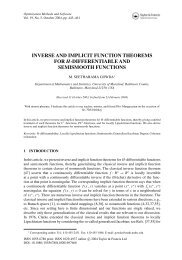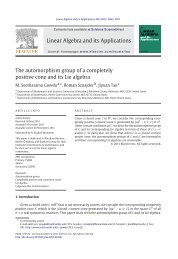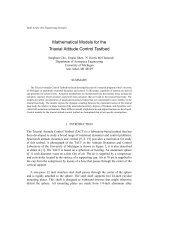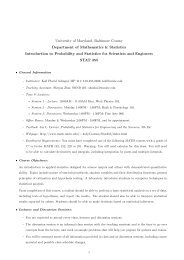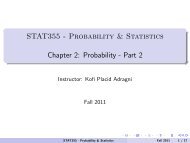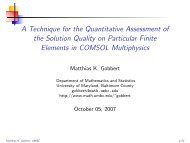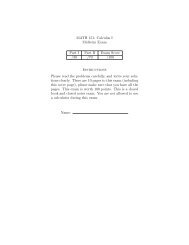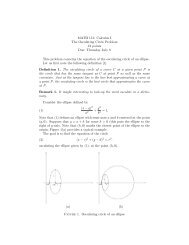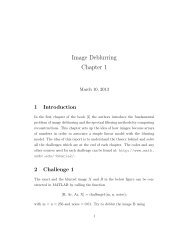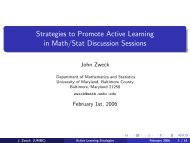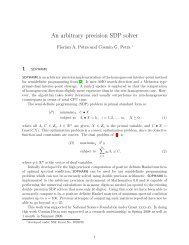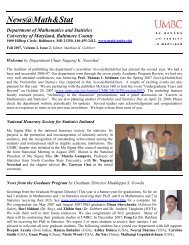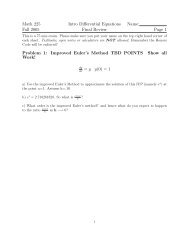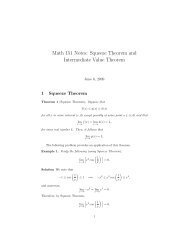STAT355 - Probability & Statistics Chapter 6: Point Estimation
STAT355 - Probability & Statistics Chapter 6: Point Estimation
STAT355 - Probability & Statistics Chapter 6: Point Estimation
Create successful ePaper yourself
Turn your PDF publications into a flip-book with our unique Google optimized e-Paper software.
<strong>STAT355</strong> - <strong>Probability</strong> & <strong>Statistics</strong><br />
<strong>Chapter</strong> 6: <strong>Point</strong> <strong>Estimation</strong><br />
Fall 2011<br />
<strong>STAT355</strong>()<br />
- <strong>Probability</strong> & <strong>Statistics</strong><br />
<strong>Chapter</strong> Fall 2011 6: <strong>Point</strong>1 Estimat / 18
Chap 6 - <strong>Point</strong> <strong>Estimation</strong><br />
1 6.1 Some general Concepts of <strong>Point</strong> <strong>Estimation</strong><br />
<strong>Point</strong> Estimate<br />
Unbiasedness<br />
Principle of Minimum Variance Unbiased <strong>Estimation</strong><br />
2 6.2 Methods of <strong>Point</strong> <strong>Estimation</strong><br />
Maximum Likelihood <strong>Estimation</strong><br />
The Method of Moments<br />
<strong>STAT355</strong>()<br />
- <strong>Probability</strong> & <strong>Statistics</strong><br />
<strong>Chapter</strong> Fall 2011 6: <strong>Point</strong>2 Estimat / 18
Definitions<br />
Definition<br />
A point estimate of a parameter θ is a single number that can be<br />
regarded as a sensible value for θ.<br />
A point estimate is obtained by selecting a suitable statistic and<br />
computing its value from the given sample data. The selected statistic is<br />
called the point estimator of θ.<br />
<strong>STAT355</strong>()<br />
- <strong>Probability</strong> & <strong>Statistics</strong><br />
<strong>Chapter</strong> Fall 2011 6: <strong>Point</strong>3 Estimat / 18
Examples<br />
Suppose, for example, that the parameter of interest is µ, the true average<br />
lifetime of batteries of a certain type.<br />
A random sample of n = 3 batteries might yield observed lifetimes (hours)<br />
x 1 = 5.0, x 2 = 6.4, x 3 = 5.9.<br />
The computed value of the sample mean lifetime is ¯x = 5.77.<br />
It is reasonable to regard 5.77 as a very plausible value of µ our “best<br />
guess” for the value of µ based on the available sample information.<br />
<strong>STAT355</strong>()<br />
- <strong>Probability</strong> & <strong>Statistics</strong><br />
<strong>Chapter</strong> Fall 2011 6: <strong>Point</strong>4 Estimat / 18
Notations<br />
Suppose we want to estimate a parameter of a single population (e.g., µ<br />
or σ, or λ) based on a random sample of size n.<br />
◮ When discussing general concepts and methods of inference, it is<br />
convenient to have a generic symbol for the parameter of interest.<br />
◮ We will use the Greek letter θ for this purpose.<br />
◮ The objective of point estimation is to select a single number, based on<br />
sample data, that represents a sensible value for θ.<br />
<strong>STAT355</strong>()<br />
- <strong>Probability</strong> & <strong>Statistics</strong><br />
<strong>Chapter</strong> Fall 2011 6: <strong>Point</strong>5 Estimat / 18
Some General Concepts of <strong>Point</strong> <strong>Estimation</strong><br />
We know that before data is available, the sample observations must be<br />
considered random variables X 1 , X 2 , ..., X n .<br />
◮ It follows that any function of the X i ’s - that is, any statistic - such as<br />
the sample mean ¯X or sample standard deviation S is also a random<br />
variable.<br />
Example: In the battery example just given, the estimator used to obtain<br />
the point estimate of µ was ¯X , and the point estimate of µ was 5.77.<br />
◮ If the three observed lifetimes had instead been x 1 = 5.6, x 2 = 4.5, and<br />
x 3 = 6.1, use of the estimator ¯X would have resulted in the estimate<br />
¯x = (5.6 + 4.5 + 6.1)/3 = 5.40.<br />
◮ The symbol ˆθ (“theta hat”) is customarily used to denote both the<br />
estimator of µ and the point estimate resulting from a given sample.<br />
<strong>STAT355</strong>()<br />
- <strong>Probability</strong> & <strong>Statistics</strong><br />
<strong>Chapter</strong> Fall 2011 6: <strong>Point</strong>6 Estimat / 18
Some General Concepts of <strong>Point</strong> <strong>Estimation</strong><br />
◮ Thus ˆθ = ¯X is read as “the point estimator of θ is the sample mean<br />
¯X .” The statement “the point estimate of θ is 5.77” can be written<br />
concisely as ˆθ = 5.77.<br />
In the best of all possible worlds, we could find an estimator ˆθ for which<br />
ˆθ = θ always. However, ˆθ is a function of the sample X i ’s, so it is a<br />
random variable.<br />
◮ For some samples, ˆθ will yield a value larger than θ, whereas for other<br />
samples ˆθ will underestimate θ. If we write<br />
ˆθ = θ + error of estimation<br />
then an accurate estimator would be one resulting in small estimation<br />
errors, so that estimated values will be near the true value.<br />
<strong>STAT355</strong>()<br />
- <strong>Probability</strong> & <strong>Statistics</strong><br />
<strong>Chapter</strong> Fall 2011 6: <strong>Point</strong>7 Estimat / 18
Some General Concepts of <strong>Point</strong> <strong>Estimation</strong><br />
◮ A sensible way to quantify the idea of ˆθ being close to θ is to consider<br />
the squared error<br />
(ˆθ − θ) 2 .<br />
For some samples, ˆθ will be quite close to θ and the resulting squared error<br />
will be near 0.<br />
◮ Other samples may give values of ˆθ far from θ, corresponding to very<br />
large squared errors.<br />
A measure of accuracy is the expected or mean square error (MSE)<br />
MSE = E[(ˆθ − θ) 2 ]<br />
◮ If a first estimator has smaller MSE than does a second, it is natural to<br />
say that the first estimator is the better one.<br />
<strong>STAT355</strong>()<br />
- <strong>Probability</strong> & <strong>Statistics</strong><br />
<strong>Chapter</strong> Fall 2011 6: <strong>Point</strong>8 Estimat / 18
Some General Concepts of <strong>Point</strong> <strong>Estimation</strong><br />
◮ However, MSE will generally depend on the value of θ. What often<br />
happens is that one estimator will have a smaller MSE for some values of<br />
θ and a larger MSE for other values.<br />
◮ Finding an estimator with the smallest MSE is typically not possible.<br />
One way out of this dilemma is to restrict attention just to estimators that<br />
have some specified desirable property and then find the best estimator in<br />
this restricted group.<br />
◮ A popular property of this sort in the statistical community is<br />
unbiasedness.<br />
<strong>STAT355</strong>()<br />
- <strong>Probability</strong> & <strong>Statistics</strong><br />
<strong>Chapter</strong> Fall 2011 6: <strong>Point</strong>9 Estimat / 18
Unbiasedness<br />
Definition<br />
A point estimator ˆθ is said to be an unbiased estimator of θ if E(ˆθ) = θ<br />
for every possible value of θ. If ˆθ is not unbiased, the difference E(ˆθ − θ)<br />
is called the bias of ˆθ.<br />
That is, ˆθ is unbiased if its probability (i.e., sampling) distribution is<br />
always centered at the true value of the parameter.<br />
<strong>STAT355</strong>()<br />
- <strong>Probability</strong> & <strong>Statistics</strong><br />
<strong>Chapter</strong> Fall 2011 6: <strong>Point</strong> 10 Estimat / 18
Unbiasedness - Example<br />
The sample proportion X /n can be used as an estimator of p, where X ,<br />
the number of sample successes, has a binomial distribution with<br />
parameters n and p.Thus<br />
E(ˆp) = E( X n ) = 1 n E(X ) = 1 n (np) = p<br />
Proposition<br />
When X is a binomial rv with parameters n and p, the sample proportion<br />
ˆp = X /n is an unbiased estimator of p.<br />
◮ No matter what the true value of p is, the distribution of the estimator<br />
will be centered at the true value.<br />
<strong>STAT355</strong>()<br />
- <strong>Probability</strong> & <strong>Statistics</strong><br />
<strong>Chapter</strong> Fall 2011 6: <strong>Point</strong> 11 Estimat / 18
Principle of Minimum Variance Unbiased <strong>Estimation</strong><br />
Among all estimators of θ that are unbiased, choose the one that has<br />
minimum variance. The resulting is called the minimum variance unbiased<br />
estimator (MVUE) of θ.<br />
◮ The most important result of this type for our purposes concerns<br />
estimating the mean µ of normal distribution.<br />
Theorem<br />
Let X 1 , ..., X n be a random sample from a normal distribution with<br />
parameters µ and σ 2 . Then the estimator ˆµ = ¯X is the MVUE for µ.<br />
◮ In some situations, it is possible to obtain an estimator with small bias<br />
that would be preferred to the best unbiased estimator.<br />
<strong>STAT355</strong>()<br />
- <strong>Probability</strong> & <strong>Statistics</strong><br />
<strong>Chapter</strong> Fall 2011 6: <strong>Point</strong> 12 Estimat / 18
Reporting a <strong>Point</strong> Estimate: The Standard Error<br />
Besides reporting the value of a point estimate, some indication of its<br />
precision should be given. The usual measure of precision is the standard<br />
error of the estimator used.<br />
Definition<br />
The standard error of an estimator ˆθ is its standard deviation σˆθ<br />
=<br />
√<br />
V (ˆθ).<br />
<strong>STAT355</strong>()<br />
- <strong>Probability</strong> & <strong>Statistics</strong><br />
<strong>Chapter</strong> Fall 2011 6: <strong>Point</strong> 13 Estimat / 18
Maximum Likelihood <strong>Estimation</strong><br />
Definition<br />
Let X 1 , ..., X n have a joint pmf or pdf<br />
f (x 1 , ..., x n ; θ 1 , ..., θ m ) (1)<br />
where the parameters θ 1 , ..., θ m have unknown values. When x 1 , ..., x n are<br />
observed samples values and (1)is regarded as a function of θ 1 , ..., θ m , it is<br />
called the likelihood function.<br />
Definition<br />
L(θ 1 , ..., θ m ) = f (x 1 , ..., x n ; θ 1 , ..., θ m )<br />
The maximum likelihood estimates (mle’s) ˆθ 1 , ...ˆθ m are those values of the<br />
θ i ’s that maximize the likelihood function, so that<br />
L(ˆθ 1 , ..., ˆθ m ) ≥ L(θ 1 , ..., θ m )<br />
<strong>STAT355</strong>()<br />
- <strong>Probability</strong> & <strong>Statistics</strong><br />
<strong>Chapter</strong> Fall 2011 6: <strong>Point</strong> 14 Estimat / 18
Maximum Likelihood <strong>Estimation</strong> - Example<br />
Let X 1 , ...X n be a random sample from the normal distribution.<br />
n∏<br />
f (x 1 , ..., x n ; µ, σ 2 1<br />
) = √<br />
2πσ 2 e−(x i −µ) 2 /(2σ 2 )<br />
i=1<br />
1<br />
= (<br />
2πσ 2 )n/2 e − ∑ n<br />
i=1 (x i −µ) 2 /(2σ 2) . (3)<br />
The natural logarithm of the likelihood function is<br />
ln(f (x 1 , ..., x n ; µ, σ 2 )) = n 2 ln(2πσ2 ) − 1 n∑<br />
2σ 2 (x i − µ) 2<br />
To find the maximizing values of µ and σ 2 , we must take the partial<br />
derivatives of ln(f ) with respect to µ and σ 2 , equate them to zero, and<br />
solve the resulting two equations.<br />
Omitting the details, the resulting mles are<br />
i=1<br />
(2)<br />
∑ n<br />
ˆµ = ¯X ; ˆσ 2 i=1<br />
=<br />
(X i − ¯X ) 2<br />
n<br />
<strong>STAT355</strong>()<br />
- <strong>Probability</strong> & <strong>Statistics</strong><br />
<strong>Chapter</strong> Fall 2011 6: <strong>Point</strong> 15 Estimat / 18
The Method of Moments<br />
The basic idea of this method is to equate certain sample characteristics,<br />
such as the mean, to the corresponding population expected values.<br />
Then solving these equations for unknown parameter values yields the<br />
estimators.<br />
Definition<br />
Let X 1 , ..., X n be a random sample from a pmf or pdf f (x). For<br />
k = 1, 2, 3, ..., the kth population moment, or kth moment of the<br />
distribution f (x), is E(X k ). The kth sample moment is (1/n) ∑ n<br />
i=1 X k<br />
i<br />
.<br />
◮ Thus the first population moment is E(X ) = µ, and the first sample<br />
moment is ∑ X i /n = ¯X .<br />
◮The second population and sample moments are E(X 2 ) and ∑ X 2<br />
i<br />
/n,<br />
respectively.<br />
◮The population moments will be functions of any unknown parameters<br />
θ 1 , θ 2 , ....<br />
<strong>STAT355</strong>()<br />
- <strong>Probability</strong> & <strong>Statistics</strong><br />
<strong>Chapter</strong> Fall 2011 6: <strong>Point</strong> 16 Estimat / 18
The method of Moments<br />
Definition<br />
Let X 1 , X 2 , ..., X n be a random sample from a distribution with pmf or pdf<br />
f (x; θ 1 , ..., θ m ), where θ 1 , ..., θ m are parameters whose values are unknown.<br />
Then the moment estimators ˆθ 1 , ..., ˆθ m are obtained by equating the first<br />
m sample moments to the corresponding first m population moments and<br />
solving for θ 1 , ..., θ m .<br />
If, for example, m = 2, E(X ) and E(X 2 ) will be functions of θ 1 and θ 2 .<br />
Setting E(X ) = (1/n) ∑ X i (= ¯X ) and E(X 2 ) = (1/n) ∑ Xi<br />
2 gives two<br />
equations in θ 1 and θ 2 . The solution then defines the estimators.<br />
<strong>STAT355</strong>()<br />
- <strong>Probability</strong> & <strong>Statistics</strong><br />
<strong>Chapter</strong> Fall 2011 6: <strong>Point</strong> 17 Estimat / 18
The method of Moments - Example<br />
Let X 1 , X 2 , ..., X n represent a random sample of service times of n<br />
customers at a certain facility, where the underlying distribution is<br />
assumed exponential with parameter λ.<br />
Since there is only one parameter to be estimated, the estimator is<br />
obtained by equating E(X ) to λ.<br />
Since E(X ) = 1/λ for an exponential distribution, this gives λ = 1/ ¯X .<br />
The moment estimator of λ is then ˆλ = 1/ ¯X .<br />
<strong>STAT355</strong>()<br />
- <strong>Probability</strong> & <strong>Statistics</strong><br />
<strong>Chapter</strong> Fall 2011 6: <strong>Point</strong> 18 Estimat / 18




